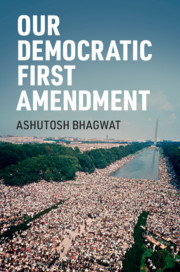Book contents
- Our Democratic First Amendment
- Our Democratic First Amendment
- Copyright page
- Dedication
- Contents
- Acknowledgments
- Introduction
- Part I The Framers’ Democratic First Amendment
- 1 Freedom of Speech and of the Press
- 2 Assembly and Association
- 3 The Petition Clause
- 4 Cognate Rights and Democratic Citizenship
- Part II The Democratic First Amendment in the Age of Twitter
- Index
4 - Cognate Rights and Democratic Citizenship
from Part I - The Framers’ Democratic First Amendment
Published online by Cambridge University Press: 28 May 2020
- Our Democratic First Amendment
- Our Democratic First Amendment
- Copyright page
- Dedication
- Contents
- Acknowledgments
- Introduction
- Part I The Framers’ Democratic First Amendment
- 1 Freedom of Speech and of the Press
- 2 Assembly and Association
- 3 The Petition Clause
- 4 Cognate Rights and Democratic Citizenship
- Part II The Democratic First Amendment in the Age of Twitter
- Index
Summary
Chapter 4 ties the themes of the first three chapters together and develops a theory of how the rights discussed in those chapters operate together to advance a particular form of active, participatory citizenship championed in the early Republic by the Republican Party of Thomas Jefferson and James Madison. The chapter’s first key point is that the rights of the Democratic First Amendment are distinct but, to use the Supreme Court’s word, “cognate.” They operate together and share a common purpose of advancing democratic self-governance. In particular, these rights are generally most effective and most important when exercised in tandem, such as through speech and petitions advanced jointly by associations. Second, these rights together were meant to create a new form of democratic citizenship. In particular, during the great battles of the 1790s between the Federalist and Republican parties, especially over the Democratic Republican Societies, the Republicans came to appreciate why the principle of popular sovereignty that drove the American Revolution necessitated a wholly new and more active role for citizens vis-à-vis their elected officials than the more hierarchical and passive model championed by the Federalists, and how the First Amendment supported that model.
Keywords
- Type
- Chapter
- Information
- Our Democratic First Amendment , pp. 81 - 98Publisher: Cambridge University PressPrint publication year: 2020

